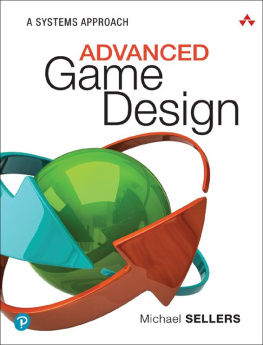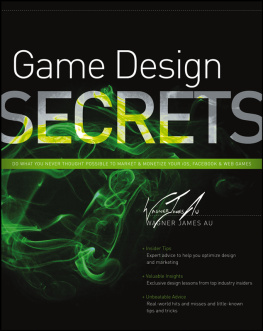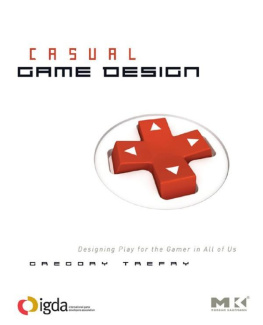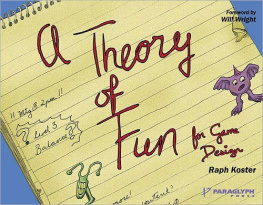CLOCKWORK GAME DESIGN
CLOCKWORK GAME DESIGN
KEITH BURGUN

First published 2015
by Focal Press
70 Blanchard Road, Suite 402, Burlington, MA 01803
and by Focal Press
2 Park Square, Milton Park, Abingdon, Oxon OX14 4RN
Focal Press is an imprint of the Taylor & Francis Group, an informa business
2015 Taylor & Francis
The right of Keith Burgun to be identified as the author of this work has been asserted by him in accordance with sections 77 and 78 of the Copyright, Designs and Patents Act 1988.
All rights reserved. No part of this book may be reprinted or reproduced or utilised in any form or by any electronic, mechanical, or other means, now known or hereafter invented, including photocopying and recording, or in any information storage or retrieval system, without permission in writing from the publishers.
Notices
Knowledge and best practice in this field are constantly changing. As new research and experience broaden our understanding, changes in research methods, professional practices, or medical treatment may become necessary.
Practitioners and researchers must always rely on their own experience and knowledge in evaluating and using any information, methods, compounds, or experiments described herein. In using such information or methods they should be mindful of their own safety and the safety of others, including parties for whom they have a professional responsibility.
Trademark notice:
Product or corporate names may be trademarks or registered trademarks, and are used only for identification and explanation without intent to infringe.
Library of Congress Cataloging in Publication Data
Burgun, Keith.
Clockwork game design / Keith Burgun.
pages cm
1. Computer gamesDesign. 2. Video gamesDesign. 3. Computer gamesProgramming. I. Title.
QA76.76.C672B859 2015
794.81526dc23
2014041373
ISBN: 9781138798731 (pbk)
ISBN: 9781315756516 (ebk)
Typeset in Berling and Futura
By Keystroke, Station Road, Codsall, Wolverhampton
CONTENTS
ELEGANCE
Like many words in the English language, the word elegance has a few different meanings. One meaning thats likely to get usage is beauty: she wore an elegant dress, for examplean entirely positive association.
Beauty usually means something like aesthetically pleasing. But the subjectivity of whether beauty should refer to any given thing means that this word is also ineffectual; a person cant be wrong about beauty, at least when it comes to what they personally consider beautiful. While it feels warm and romantic, the word doesnt actually do much of what words usually do, which is to describe something. In the context of a technical textbook, words can be judged by their explanatory power, and, by this metric, beauty does not fare well. When a person says that they find something beautiful, all you can glean from this is that they value that thing in some way.
A more useful definition for the term elegance might be something like efficiencyaccomplishing as much as possible with as little as possible. When looked at in this way, elegance is much more well-defined, and its even possible to loosely quantify. In this case, however, we have almost the opposite problem: people see efficiency as a cold, inhuman, or non-artistic quality that is best pursued by machines.
Worse yet is the common mistake of believing that achieving efficiency is easy. The thinking goes something like this: to be efficient, all youve got to do is plug a few numbers into an algorithm, and youve now got the correct, ideal answer for how to accomplish your task. Its so simple, a primitive computer could do it! The real difficulties, the mythology tells us, are in achieving the human or emotional thingsmaking people laugh, deep philosophical insight, portraying personality, and the like.
The problem with this way of thinking, at least with regards to game design or any other creative craft, is that in practice there is never some simple algorithm that you can plug numbers into. Game designers operate in an extremely complex world, creating complex machines for complex humans to interact with. In such a context, finding efficiency is every bit as hard as any other task a person can take on, and requires all of the same human/artistic skills of creating a great painting or composing a great piece of music. Art is a mechanical process of problem-solving; an engineering problem and, as such, efficiency is a requirement.
It would be wonderful if we could allow some of that romance we associate with beauty to bleed over into our understanding of what efficiency is. Perhaps a better use of the term beautiful would be to use it to indicate when something is worthy of the same sort of profound positive association that the word beauty itself gets. Beauty is like glitter that you dust across the surface of other concepts that communicates, I challenge you to see this thing as profoundly positive.
Efficiency is beautiful. But more than that, its just what we do. Human beings, living in a world of finite resources, must always strive to take the most conservative action. We cannot afford to take five years doing a job that we could achieve in four. All else being equal, we will always choose the option that gets the biggest yield for the smallest investment. In fact, the opposite of efficiency is pure wastefulness, ignorance, or carelessnessall profoundly negative qualities.
Writing, like game design or any other craft, is a constant search for efficiency. We are always placing a stroke, a note, a line, a rule, and then trying to find alternatives that are more efficient. In this book, I will generally use the word elegance to refer to efficiency. Elegance contains much of the technical definition of efficiency, along with some of the profound goodness of beauty. In this way, the word elegance itself is more elegant than its alternatives.
This book is about the search for elegance in game design.
WHAT IS THIS BOOK?
This book is a guide to better strategy game design. It uses a combination of core philosophy, analysis of existing systems, exercises, critical questions, charts, and other elements to build a consistent and solid process for designing great games.
Something to know up front is that this is not a book about game development. This book will not teach you how to manage a team, set deadlines, become a programmer, rig 3D models, or any such technical game development skills.
This book also doesnt spend much time dealing with the practicalities of game design in real life. Whether youve got a $10 million budget and a thousand employees, or whether its just you designing a game on paper before you go to bed, the principles of good game design apply, and thats what this book focuses on. Its up to you to figure out how best to apply these principles in your own unique situation.
Since this is a book for game designers or people who teach game design, this book assumes that the reader has a basic knowledge about at least some of the most popular games. It assumes that the reader knows things such as the rules to chess, Tetris, and Super Mario Bros. It does not, however, assume that the reader is an expert on games, so more obscure references will be explained in enough detail to be useful.
STRUCTURE
The first chapter, Theory, serves as a basic conceptual and theoretical overview: what is a game? Well dive deep into the question and get some solid understanding of this form and its values. Also: what other kinds of interactive forms exist, aside from games? How do these relate to, and interact with, strategy games? In this chapter well also review some of what has already been said on the topic.
Next page
![Keith Burgun [Keith Burgun] Clockwork Game Design](/uploads/posts/book/119426/thumbs/keith-burgun-keith-burgun-clockwork-game-design.jpg)

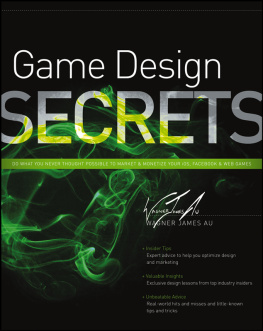
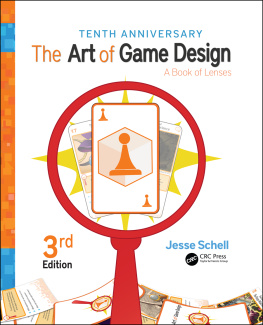
![Jesse Schell [Jesse Schell] - The Art of Game Design, 2nd Edition](/uploads/posts/book/119435/thumbs/jesse-schell-jesse-schell-the-art-of-game.jpg)
![Wagner James Au [Wagner James Au] - Game Design Secrets](/uploads/posts/book/119431/thumbs/wagner-james-au-wagner-james-au-game-design.jpg)
![Ethan Ham [Ethan Ham] - Tabletop Game Design for Video Game Designers](/uploads/posts/book/119417/thumbs/ethan-ham-ethan-ham-tabletop-game-design-for.jpg)
